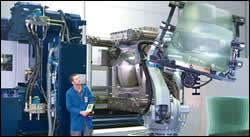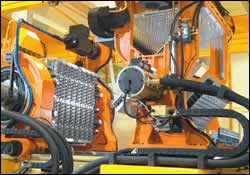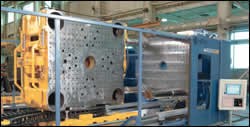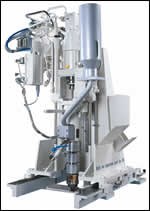NPE News Wrap-Up: Injection Molding
Stress-free production of large car windows, in-mold painting, and an injection unit that applies pack and hold while accumulating the next shot were a few of the cutting-edge technologies on display.
New capabilities that challenge conventional approaches to molding dominated this year’s NPE show. A novel hinged mold that distributes melt through an injection-compression process without clamp motions is one example. New injection units that overlap plasticating with pack and hold phases are another. In-mold painting, high-speed injection without an accumulator, and PET preform machines that achieve unheard-of output rates were still more novelties demonstrated in Chicago. In addition, there were lots of new electric machines, vertical models, LSR systems, micro-molders, and multi-component presses galore.
Rethinking injection
A new design of the injection unit addresses issues of melt quality, process control, and shot-weight accuracy associated with conventional reciprocating screws. The new Injection Control Unit (ICU) from Xaloy was designed by Robert Dray of R. Dray Manufacturing in Dallas, who notes at least three limitations of reciprocating screws. First, he says the intermittent plasticating action and the inconsistent plasticating length “seen” by the melt negatively affect melt consistency and quality. Second, the non-return valve compromises shot-size accuracy and consistency. Third, reciprocating screws are limited in shot-size flexibility because residence times are extended and shot-size accuracy diminished when attempting small shots from an oversized barrel.
The ICU design reportedly eliminates these problems. It is a special two-stage system that uses an extruder with a fixed screw to plasticate polymer, and then a separate specially designed ram system to inject the material. Plasticating is said to occur at lower temperatures and backpressures than a reciprocating screw while delivering higher throughput rates by means of an advanced screw design. Use of the fixed screw makes the full gamut of extrusion screw-design technology available to injection molders, Dray points out. In-line compounding and molding should be readily feasible.
Instead of a shut-off nozzle, the system uses an extended nozzle that blocks off the melt-feed channel from the extruder during the injection stage. Movement of the injection carriage—normally used for sprue break—is the key to the system’s operation. As shown in the accompanying diagram (top), when the carriage is in the forward position, melt from the extruder flows through an orifice in the nozzle and accumulates in front of the plunger. The plunger applies backpressure control in the normal fashion. When the shot is accumulated, the injector carriage moves back, retracting the nozzle so that it blocks off the melt-feed channel (bottom diagram). Injection then takes place. After the plunger reaches its forward position, the carriage advances so that shot recovery can occur while pack and hold pressure are applied by a torpedo on the end of the injection nozzle. The small diameter of the torpedo provides much finer control of packing and holding than does the much larger-diameter injection ram, says Dray, thereby providing tighter control of ultimate part quality. Shot-weight accuracy is said to be ±0.1%.
In this design, shot recovery does not limit cycle time, as plasticating can operate during all phases of the cycle except during the brief injection fill phase. The screw can run continuously, as long as the interruption of flow for injection is no more than a couple of seconds. Dray also claims that the ICU can accommodate a wider range of shot sizes without penalty. Even micro-molding becomes possible by holding the injection plunger forward and using only the torpedo to fill the mold.
The ICU system can be retrofitted to a wide range of press sizes and can use the existing injection barrel. Retrofit cost ranges from $17,000 to $22,000 depending on model.
Meanwhile, sources at Ferromatik Milacron Europe revealed that another new variant of two-stage molding is in the prototype R&D stage at the company’s German headquarters. Like the Xaloy system, Ferromatik’s has a proprietary mechanism for applying pack and hold pressure independent of the injection plunger. This approach trims cycle times by speeding shot recovery. Based on Ferromatik’s K-Tec hydraulic press, the system is suited to applications with short injection and long packing times.
More pioneering processes
Probably the most dramatic demonstration at the show was stress-free molding of large polycarbonate car windows at Battenfeld’s booth. The application used a new PC material developed by Exatec LLC of Wixom, Mich., the joint venture of GE Plastics and Bayer Corp. (see PT, July ’03, p. 62). The key to the process was an unusual injection/compression technology dubbed IMPmore (In-Mold Pressing), which teamed a Battenfeld HM hydraulic press with tooling from Summerer Technologies of Germany and a Synventive hot-runner system. Battenfeld molded a 4-mm-thick tailgate window weighing 11 lb and measuring 11 sq ft, or about 1 sq meter, on a 2200-ton press. Normally a part this size takes a 4000- or 4500-ton machine. A smaller press was made possible by the need for low-pressure injection to avoid stresses and thickness variations with the viscous PC material.
Battenfeld contributed a special barrel and screw design. Summerer came up with special tool that has a tilting top half. The tilting action is designed to pool the injected melt in the top half of the mold under low pressure. Then the top of the mold tilts back into its fully closed position—like a book cover closing—which squeezes the melt down into the rest of the cavity under low pressure. A row of retractable cylinders in the bottom of tool extend out to touch the other mold half, providing counterpressure in the tool during the initial injection phase when the melt is pooled at the top. The cylinders retract to a flush position during the compression stage.
Engel demonstrated its new X-Melt process for the first time in North America. This novel approach to high-speed injection pre-pressurizes the melt in the barrel, then lets the melt explode into the cavity at rates up to 2590 mm/sec (102 in./sec)—without an accumulator. The process appears to be limited in application to relatively small, thin-wall parts and shot weights up to 40 g. Cavitation must be low (up to four so far). The injection screw pressurizes the melt behind a special shutoff nozzle designed to withstand pressures up to 43,000 psi. The process requires the use of an electric screw drive to achieve precise screw positioning and to keep the screw from moving once the shutoff valve opens. Engel worked with Mold-Masters to minimize pressure drop in the hot-runner system.
At the show, X-Melt was demonstrated on a 60-ton E-motion all-electric tiebarless machine that molded four DVD gear drives from LCP. Engel has sold 10 X-Melt systems so far, five of them in the U.S. One developmental application is an ABS/PC cell-phone cover with a wall thickness of just 0.011 to 0.019 in. and a fill time of 0.08 sec.
Ube Machinery demonstrated its new Imprest in-mold painting system to produce parts with Class A painted finish right out of the mold. The system first injects the substrate and molds the part, then the tool opens slightly to allow injection of the paint (formulated by Sherwin-Williams) from a delivery system built into the mold. The tool closes again, distributing the paint evenly over the substrate. The paint cures inside the mold to a thickness of 40 to 70 microns. The paint-delivery system includes a recirculating device and controller stationed next to the press. The paint is 100% solids, so there reportedly is no orange peel and no release of VOCs. The paint is also formulated to release easily from the mold. So far, the in-mold paints are suitable for ABS, PC, and nylon. Paints for PP are still being developed.
In-mold painting of thermoplastics has been in development for more than a decade, so far without much commercial success. What’s different now, according to Ube spokesmen, is the arrival of all-electric presses that can precisely control clamp position, which determines the thickness of the paint. Ube says commercial use of Imprest could begin in Japan this year, though the process will become available here in 2005.
A new application of sequential valve gating is designed to run family molds while minimizing clamp tonnage. Shown by MHI Injection Molding Machinery (Mitsubishi), this Sequential Cavity Separation (SCS) technique profiles the injection, pack, and hold phases for each cavity separately. The cavities are filled in sequence from the largest part to the smallest.
Electrics take charge
Toshiba Machine Co. brought out its new all-electric EC-N series, which uses linear servo motors to drive injection velocity at speeds up to 2000 mm/sec. Response time (dead stop to top speed) is currently 50 millisec though the firm is working toward 20 millisec. Such high speeds are aimed at complex thin-wall parts. Press sizes range from 45 to 110 tons. Wide platen is standard, though overall machine footprint has been reduced. The machines are not yet available here.
Ferromatik Milacron North America introduced a new 6-ton all-electric press for micro-molding. The Mila cron/Fanuc Roboshot Si-A has a 14-mm screw. Milacron also said that 124 Roboshot Si-B all-electric machines were recently delivered to an unnamed customer, creating what is believed to be the world’s largest all-electric molding plant.
Netstal Machinery, which already offers e-Jet all-electric toggle machines for optical discs, plans to launch an all-electric press for technical parts late next year. Initial sizes will range from 50 to 175 tons.
Arburg showed a new size of its hybrid Allrounder C Advance series, which has electric plastication, injection, and clamping, plus electric or hydraulic ejection, core pull, and carriage movement. A new 165-ton model fills in the gap between the 143- and 176-tonners previously introduced.
Van Dorn Demag showed off a prototype 110-ton model of a direct-drive (beltless) all-electric unit in its new IntElect DD line. The system will likely become commercially available in 2004.
Haitian Machinery Co. from China introduced its HTD line of all-electric toggle presses, which have one servomotor for plasticating, two for injection, and one each for clamping and ejection. Sizes range from 60 to 300 tons. The line will become available this fall.
Kawaguchi Inc. will broaden its product line in North America when its new KXE all-electric toggle press becomes commercially available here by the end of the year. Three models will be offered: 55, 110, and 200 tons. They use servomotors for all primary motions and a hydraulic power pack for ejection. The controller has an 8.5 x 7 in. color touchscreen.
LG International America says all but the two largest models in its new Korean-built LGE all-electric line (33 to 330 tons) will be available here next year.
Negri Bossi America, which set up shop in Newark, Del., in March, showed its new all-electric Elma models in 100- and 180-ton versions, as well as a 935-ton Vector series hybrid press with an electric motor for screw rotation.
MIR says the first quarter of 2004 is the scheduled release date for its Atomic line of direct-drive all-electric machines with Tomicon Windows-based PC control. Replacing standard PLC controls, it has touchscreen graphics and capability for remote monitoring and troubleshooting. Sizes range from 154 to 440 tons.
Sumitomo introduced to North America its new hybrid line designed for packaging and other ultra-high-speed applications. The new SE-HY series of 385 to 485 tons has servo-driven plastication, clamping, and ejection plus accumulator-assisted hydraulics with a digital servo valve for injection, hold pressure, backpressure, and screw pull-back. Sumitomo also plans to begin U.S. manufacturing of its SED series direct-drive all-electric models from 55 to 200 tons and of its SES series belt-driven all-electrics of 250 to 385 tons. Manufacturing will take place at the Jefferson, Ga., plant that also builds Sumitomo’s hydromechanical series.
Toyo of Japan (represented here by Maruka U.S.A.) displayed its new 750-ton Plastar Si all-electric model with the newest PLCS 10 control system, seen here for the first time. The series, which previously topped off at 300 tons, also now has 400- and 500-ton models. Toyo also has new Super Resin software that controls shot size by means of melt-pressure sensing.
Multi-component injection
The growing popularity of multi-component molding was evident in numerous machinery displays. For example, Van Dorn Demag showed its self-contained Multi-Plug injection units, which can be placed in a horizontal, vertical, parallel, or piggyback position. They come in eight sizes suited to presses from 50 to 385 tons. Also new to the U.S. are Van Dorn El-Exis Multi hybrid multi-component presses.
Krauss-Maffei’s new two-platen Revolution series multi-component units are offered in sizes from 200 to 4400 tons. These have opposing injection units on the stationary and moving sides of the clamp (one injector moves with the mold). There is a rotary stack mold on presses up to 800 tons and indexing mold systems on larger sizes. The rotary stack is hydraulically indexed by 90° or 180° per cycle. The moving-platen injector can be added to a standard two-component press for three-component molding.
Krauss-Maffei also brought out its first line of portable bolt-on injection units in vertical and L configurations. The systems use the MC4 control and injection units from the company’s C series machines. Interfacing the unit to the primary machine is said to be quick and simple, providing a low-cost way to upgrade to two-component capability. The vertical injector is offered in three sizes with shot capacities of 21 to 258 cc, while the L version comes in four sizes from 21 to 456 cc.
Negri Bossi America showed its first multi-component offering, which uses the Twinshot coinjection technology from Spirex. Twinshot molds two-component sandwich structures using a single screw of special design.
LSR draws attention
Liquid silicone (LSR) molding showed up at half a dozen machinery booths. Engel used a 110-ton E-Motion tiebarless all-electric press to demonstrate a fast-cycling LSR application. It molded connector seals in a 256-cavity mold in 14 sec using a 25-mm reciprocating screw and 1.9-oz shot.
Arburg produced LSR O-rings in 128 cavities. Krauss-Maffei demonstrated its Silcoset LSR technology on a 165-ton Eltec all-electric press. Boy Machines produced two-color LSR baby-bottle nipples on a Model 22 A with a two-component feeding system from Fluid Automation Systems.
Toshiba Machine Co. America is also teaming up with Fluid Automation to develop a micro-molding model for LSR by next January.
NPE marked the North American debut of Nissei’s NEX 500 55-ton all-electric press, which demonstrated LSR micro-molding with a shot size of 0.0026 oz. Its plunger has a 0.31 in. diam.
Verticals in volume
Vertical presses were also plentiful at the show. Engel showed a vertical-clamp, vertical-injection unit for the first time. The 90-ton VV model had a new “no-lift,” high-speed rotary table. The new configuration accommodates standard hot-runner molds and eliminates the need for sprue break, which can reduce cycle time. The fully hydraulic model uses dual “smart” pumps for increased part-to-part repeatability. At the show, the machine used a 40-mm screw and 6.5-oz shot to produce eight nylon rollers in 40 sec.
Gluco’s VS series of vertical presses has been redesigned from a C-frame construction to a four-tiebar configuration in sizes of 100 tons and up. The line comes in shuttle, rotary, and single-station designs.
Haitian Machinery is partnering with Sanjo of Taiwan to develop a vertical-injection, vertical-clamp press for insert molding.
Niigata Plastic Machinery, distributed by DJK Global Group, showed its new S4 controller on its MDVR vertical rotary electric presses and on its new vertical-clamp line with vertical or horizontal injection.
Nissei unveiled a new 171-ton, all-electric, vertical-clamp model, the Elject TD 150RE. The new model is the largest in the line, which starts at 40 tons, but it will be overtaken by a 200-tonner next year. The system has a new servo-driven rotary table for more precise movement than the previous hydraulic table.
Sodick (sold here by Yamazen) has a new vertical machine line that uses electric servomotors for mold open/close, plasticating, and injection. Clamping is accomplished by a self-contained hydraulic system within the fixed platen, just like on the firm’s horizontal models.
PET preform systems
Husky Injection Molding Systems rolled out two major developments in PET preform machines. First, Husky modified its Index line of rotary-platen preform systems to reduce tooling costs. The rotary platen now carries two sets of mold cores instead of four and rotates 180° per cycle instead of 90°. Eliminating the extra cooling time on the rotary platen is compensated by the addition of a new Post-Mold Cooling (PMC) device that takes preforms from the rotary platen and water-cools the parts inside and out during four molding cycles. At the show, a new 600-ton Index system with a 144-cavity mold produced carbonated soft-drink preforms in a 10.8-sec cycle. The system can be optimized to run even faster, Husky says. The new Index line will be offered in the next 12 months in three models from 125 to 600 tons, able to run molds from 6 to 144 cavities.
Husky also rolled out a new HyPET preform system to replace its G-PET model. The new units are based on Husky’s Hylectric hydromechanical design with electric screw drive. The HyPET system is said to operate 5% faster with lower energy usage. It occupies up to 20% less floor space. HyPET machines use single-face molds with up to 48 cavities. They feature Husky’s new CoolJet technology for forced-air cooling inside the preforms. They also have Husky’s Reflex platens, wide tiebar spacing, and Polaris controls. HyPET models from 120 to 440 tons will become available over the next year.
Kortec Inc. introduced a new 8-cavity coinjection system for multi-layer PET barrier preforms. The new AR150/8 system is for low to medium volumes of 8 to 12 million preforms/yr. This system is based on Arburg’s Preliner PET machine. It can handle neck diameters from 26 to 43 mm using the same mold base. Auxiliary features include a barrier-resin drying package and liquid-color dosing equipment. The firm also recently developed a 72-cavity coinjection preform system and is working on a 144-cavity system.
Netstal is investigating a twin-screw concept for its preform machines in order to achieve higher PET plasticating rates while retaining low acetaldehyde (AA) content.
Lots more presses
Chen Hsong Machinery Canada, the North American office of the Hong Kong machinery maker, offers its C-series hydraulic toggle press in sizes from 55 to 468 tons. The line has been available in Asia for two years but is new to the North American market. The firm also offers a high-speed hydraulic toggle line called the Supermaster HS from 88 to 250 tons.
Van Dorn Demag introduced its new Ergotech Extra line of machines with hydraulic clamps from 28 to 120 tons and toggles from 140 to 220 tons. They feature an automatic start-up and shutdown program that preheats the oil, barrel, and mold without operator intervention. Van Dorn also introduced a 950-ton model in its Caliber two-platen hydromechanical line. It has the firm’s recently introduced Path finder 6000 controls.
HPM rolled out a prototype of its Freedom Rotator, a two-platen machine with an optional rotating center platen. The press, offered initially in an 1100-ton model, is designed for insert, multi-color, and coinjection applications. Productivity is said to be up to 35% higher than conventional machines. This design shifts the tiebars, which are normally mounted on the moving platen, to the stationary platen. The company will also offer a Freedom Hybrid hydromechanical series with an optional electric screw drive in sizes from 360 to 5000 tons.
Krauss-Maffei is now supplying its new MX series of hydromechanical presses (880 to 4400 tons) in the U.S.
Milacron unveiled a new 1000-ton, high-speed addition to its Maxima two-platen line. The new Maxima 1000HS model is designed for thin-wall packaging. It features an electric screw drive and clamp speed of 70 in./sec to deliver 3.5-sec dry-cycle time with a 42-in. stroke. The unit is also available with a two-stage servo-electric injection unit.
Milacron also announced delivery of the first two Maxima two-platen presses fitted with a new two-sided, stack-type mold-carrier system designed by Ferromatik Milacron and sister firm D-M-E. The system, which carries two conventional single-face molds, is offered on Maxima models from 310 to 6000 tons. The first two units are 450-tonners that will produce closures.
Nissei’s new FN AN1 series is a modification of its AN series tailored specifically for packaging. The screw is longer for higher output and good mixing. Also new is the ability to overlap screw recovery and clamp movements for shorter cycles. It is currently offered in sizes from 200 to 1000 tons.
Sandretto USA is rolling out a more modular S version of its Series Nine hydraulic toggles. The new models have a one-piece instead of two-piece frame and a simpler hydraulic package. The sef2000 controls are the same, and the line is offered in 14 sizes from 75 to 485 tons.
Ube introduced its new Z-Max UZ line of fully hydraulic presses in four sizes from 500 to 1500 tons. The new series will be built here. It features new Q series PLC controls from Mitsubishi, and a PC-based operator interface that allows for remote maintenance and troubleshooting. The new wide-platen design allows use of larger molds. For example, a mold designed for a conventional 1200- to 1500-ton press can run in a UZ 1000-tonner.
Haitian has a new two-platen line that will become available in early 2004. The HTK line will range from 65 to 2800 tons and will be the first line from Haitian sold here with off-the shelf components such as Vickers valves and Siemens controllers.
Related Content
Midtonnage Hybrid Range With Compact Footprint Launches
NPE2024: Milacron has the global launch of its new M-Series injection molding machine line featuring a large clamp stroke as standard in a line of midtonnage, compact-footprint machines.
Read MoreMilacron’s Massive Booth Highlights Multiple Brands
NPE2024: Coinjection of postconsumer resin, in-mold decoration, LSR micromolding and bioplastics processing are just some of the machine displays at Milacron's booth.
Read MoreArterex Acquires Micromold
The medical device contract manufacturing company with eight facilities globally has purchased the Riverside, California-based micromolder.
Read MorePrecision Processing Requires Precision Equipment
Moretto offers plastics processors and micromolders for a broad suite of auxiliary solutions targeted specifically for precision processing.
Read MoreRead Next
Beyond Prototypes: 8 Ways the Plastics Industry Is Using 3D Printing
Plastics processors are finding applications for 3D printing around the plant and across the supply chain. Here are 8 examples to look for at NPE2024.
Read MoreLead the Conversation, Change the Conversation
Coverage of single-use plastics can be both misleading and demoralizing. Here are 10 tips for changing the perception of the plastics industry at your company and in your community.
Read More



1.gif;width=860)
2.gif;width=860)













